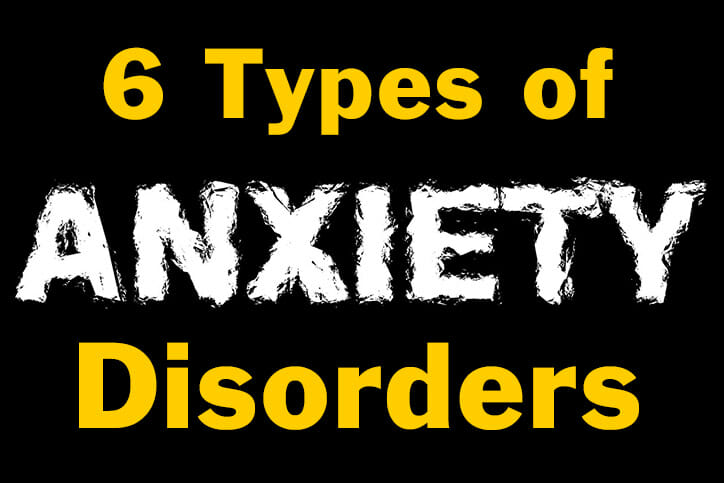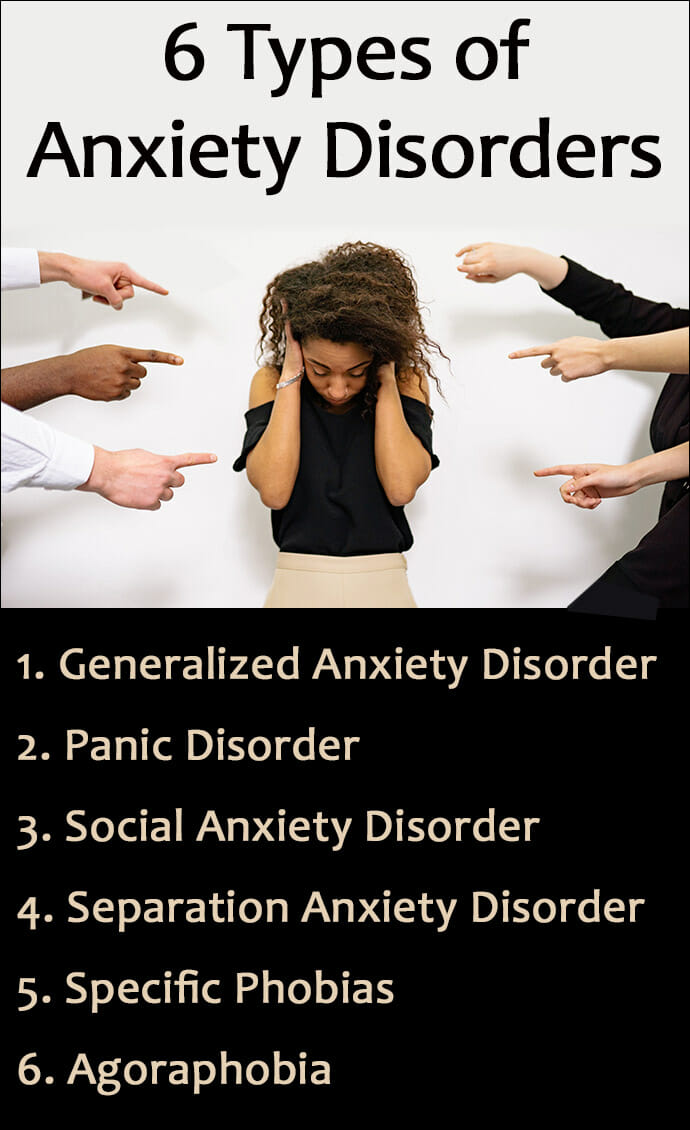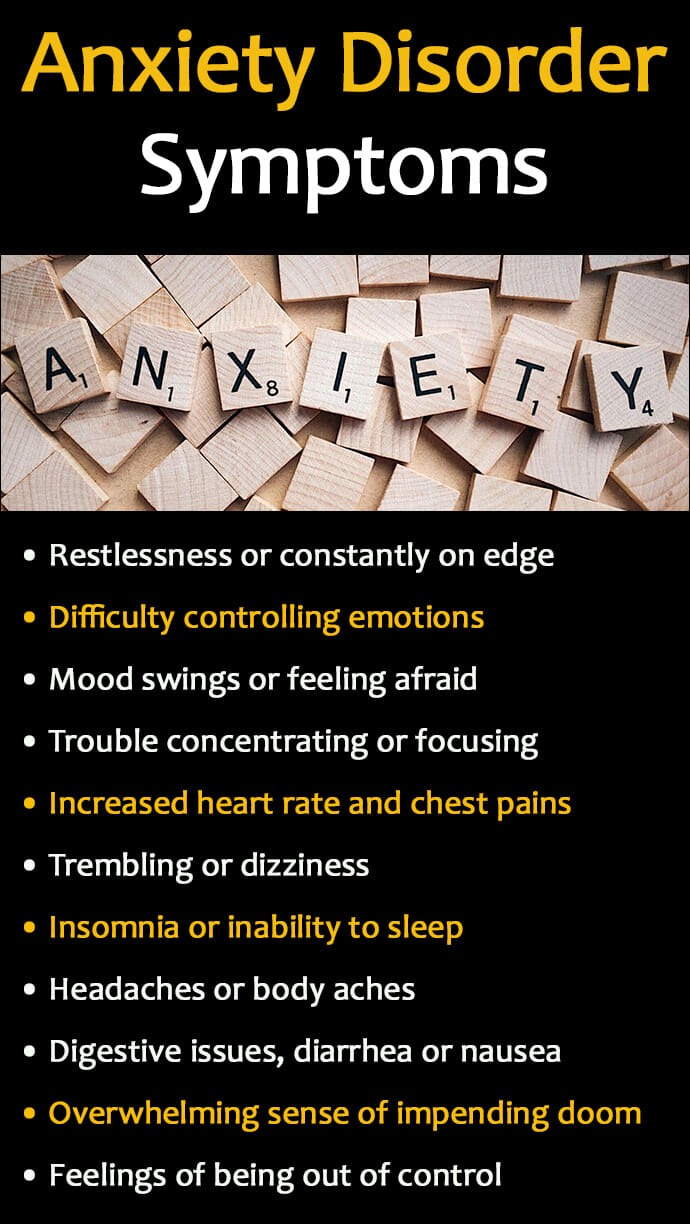Guarding our mental health is becoming more difficult in today’s high-stress world, and it’s even harder for people who cope with various types of anxiety disorders.
Being human means dealing with anxiety. It is impossible to avoid worry about loved ones, personal health, finances, or an endless number of other issues.
However, living with an anxiety disorder involves much more than a nagging fear or lingering angst.
Understanding the different types of anxiety disorders, as well as the causes, symptoms, and treatments can help people identify and overcome their own problematic thought patterns.
It can also help people without excessive anxiety learn to have empathy for those who struggle with the various types of anxiety disorders.
What is Anxiety Disorder?
First, it’s important to know that anxiety disorders are the most common mental illness in the United States and around the world.
Nearly 20 percent of adults – around 40 million people – experience anxiety disorder in a given year, according to the Anxiety and Depression Association of America (ADAA).
Anxiety Disorders are a mental health condition that leads to feelings of fear and dread, often prompting a physical response, such as an elevated heart rate, sweating and difficulty focusing. They can be so intense they disrupt a person’s ability to function normally.
People with anxiety disorders are often stigmatized for overreacting to situations or environments that others do not find at all stressful. In reality, many people living with anxiety disorders are unable to control their response to these events.
There is also a spectrum of different types of anxiety disorders with varying diagnostic criteria.
What are 6 Types of Anxiety Disorders?
Living with this form of mental illness can be extremely difficult, but one of the keys to treatment and recovery is an accurate diagnosis.
Here are 6 Types of Anxiety Disorders:
1. Generalized Anxiety Disorder (GAD)
Generalized Anxiety Disorder (GAD) is one of the most common types of anxiety disorders and is characterized by worry and excessive anxiety about an array different life situations, for more days than not for at least six months.
Typically a person suffering with generalized anxiety disorder finds it difficult, if not impossible, to control or suppress their anxiety levels.
2. Panic Disorder (PD)
Panic Disorder (PD) can develop for people who have had multiple panic attacks, or worry about having them.
Panic attacks are sudden surges of fear or severe discomfort that within minutes can grow in intensity and lead to symptoms like difficulty breathing, dizziness, heart palpitations, sweats, trembling and even a fear of dying.
With panic disorder, the attacks are more frequent and include at least four severe symptoms.
3. Social Anxiety Disorder
Social Anxiety Disorder is a very common type of anxiety. People with this condition experience a serious and persistent fear of being watched and judged by others in what might seem like normal environments to others.
The anxiety is typically out of proportion to the reality of the social situation, but people sometimes find it impossible to control the anxiety they’re experiencing.
Many celebrities with anxiety deal with this condition despite being in the public eye as part of their career.
4. Separation Anxiety Disorder
People with a diagnosis of Separation Anxiety Disorder battle an excessive and inappropriate fear of separation from someone they are attached to.
This can include the fear that harm may come to the person they are attached to, an inability to be alone without them, or the refusal to leave that person to go to school, work, or other activities.
5. Specific Phobias
Specific Phobias is a type of anxiety disorder characterized by intense fear of a specific object or situation, such as a fear of spiders, a fear of flying, or seeing blood.
The specific situation or object tends to cause immediate anxiety that is out of proportion to the actual reality of the situation.
6. Agoraphobia
People suffering with Agoraphobia typically try to avoid being outside of the home alone or being in enclosed or crowded public spaces out of fear that they might not be able to escape if they develop symptoms of a panic attack.
Agoraphobia is similar to specific phobias, although the fear is related to not being able to escape the situation of being on an airplane if a panic attack occurs, whereas a specific phobia would actually be a fear of flying.
Other Types of Anxiety Disorders
The 6 types of anxiety disorders listed above are the most commonly diagnosed, although there are others with qualifying diagnostic criteria.
Some of these include:
- Substance/Medication-Induced Anxiety Disorder
- Anxiety Disorder Due to Another Medical Condition
- Selective Mutism (this is mostly for children)
Even though anxiety is not a mood disorder, the cause of a Substance/Medication-Induced Anxiety Disorder is similar to a substance induced mood disorder.
What Causes Anxiety Disorders?
Unfortunately, many people, including those who suffer from anxiety disorders, assume that the conditions are caused by some moral failing, character flaw, or lack of inner strength. This is simply not the case.
Researchers have yet to pinpoint the exact cause of anxiety disorders, but data shows there are a number of common factors at play.
Common Causes of Different Types of Anxiety Disorders Include:
Genetics
Genetics plays a role with many mental health issues, and various types of anxiety disorders are often inherited from one or both parents who might have also had parents that suffered from issues of anxiety.
Brain Chemistry
Research has shown that chronic, prolonged stress can actually alter Brain Chemistry and affect a person’s overall mood and emotions. It’s quite common for chronic stress to lead to a person developing an anxiety disorder.
Environment
A chaotic or traumatic environment, whether current or past, can trigger serious anxiety issues and the development of an anxiety disorder. This is especially true for people who are at a higher risk, such as those who had a parent or grandparent that also struggled with an anxiety disorder.
Anxiety Disorder Symptoms
While anxiety disorder symptoms across each type of the condition may vary in intensity and severity, the primary symptom is fear.
Being able to identify the symptoms of anxiety disorder can help a person recognize that they are experiencing a mental health problem and seek help.
Common Symptoms of Anxiety Disorders can include:
- Restlessness, feeling wound-up, or constantly on edge
- Difficulty controlling emotions
- Mood swings, such as feeling afraid to feeling irritable
- Trouble concentrating or focusing
- Increased heart rate, chest pains, and sweats
- Trembling or dizziness
- Insomnia or inability to sleep due to excessive worry
- Headaches or body aches
- Digestive issues, such as diarrhea or nausea
- An overwhelming sense of impending doom
- Feeling as if you or events around you are completely out of control
While anxiety disorder symptoms may be more or less severe for each individual, the condition is likely to worsen without proper treatment.
The good news is that anxiety disorders are highly treatable, especially if treated early before they become more severe.
Anxiety Disorder Treatment
It’s important to realize that anxiety disorders are legitimate health issues that require treatment for recovery and they often will not go away on their own in most cases.
A discussion with a family doctor might be the first place to begin. This is a helpful way to learn about the different types of anxiety disorders and develop a plan for treatment with a mental health professional.
One of the dangers of many types of anxiety disorders is self-medicating with drugs or alcohol to cope with the symptoms.
Prolonged use of drugs or alcohol can lead to a co-occurring disorder, which is the combination of a mental health disorder (anxiety) along with a substance use disorder (addiction).
For people who have developed a dependency to drugs or alcohol as a way to manage their symptoms, dual diagnosis treatment may be necessary to overcome both the substance use disorder and the anxiety disorder.
For most people, successfully treating anxiety disorders sometimes involves medications, therapy and counseling, or a combination of both.
Medications for Anxiety Disorders
Benzodiazepines
Benzodiazepines like Xanax or Klonopin are sometimes prescribed to decrease anxiety symptoms and calm the brain. These are generally only prescribed for a short time because they can be habit forming and must be tapered off as prescribed.
Antidepressant Medications
Antidepressant medications, such as selective serotonin reuptake inhibitors (SSRIs) like Lexapro, Paxil, Zoloft, or Prozac can help regulate the amount of serotonin in the brain.
Beta-blockers
Beta-blockers are usually prescribed for high blood pressure, but they may be helpful for reducing some of the physical effects of anxiety, such as a rapid heart rate, trembling, or shaking
Therapy and Counseling for Anxiety Disorders
Individual Therapy
Individual therapy sessions with a psychologist or psychiatrist will help identify the roots causes of a person’s anxiety and find solutions or techniques that are useful for managing the triggers and symptoms.
Cognitive Behavioral Therapy (CBT)
Cognitive Behavioral Therapy is a very effective approach for treating anxiety disorders. CBT teaches people to recognize problematic thought patterns and behaviors that lead to fear and worry, and work on changing the thoughts and behaviors before they lead to greater symptoms.
Exposure Therapy
Exposure Therapy might sound radical or harsh, but it has shown to be useful for helping people with anxiety engage in environments or situations they have avoided through the use of relaxation and imagery exercises.
Lifestyle Changes
There’s a lot to be said about improving many mental health issues through proper diet, exercise, and adequate sleep, because they all work so well. Making small changes to improve all three areas can instill a sense of accomplishment while reducing stress and anxiety.
School and work can be incredible stressors that cause anxiety for a lot of people. Take comfort in knowing that school won’t last forever. If a career change is inevitable, there are many jobs for people with anxiety that make going to work each day less stressful and more enjoyable.
There’s no shame in seeking help for anyone struggling with the types of anxiety disorders and symptoms outlined here. Getting a diagnosis and treatment at the first sign of an issue will make it easier to recover and avoid years of living in fear.






